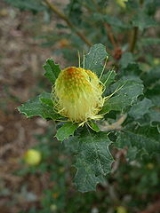
Banksia undata var. undata
Encyclopedia
Banksia undata var. undata is a shrub
endemic to Western Australia
.
It was known as Dryandra praemorsa var. praemorsa until 2007, when all Dryandra species were transferred to Banksia
by Austin Mast
and Kevin Thiele
. As there was already a plant named Banksia praemorsa
(Cut-leaf Banksia), Mast and Thiele were forced to chose a new specific epithet; their choice, "undata", is from the Latin
undatus ("undulate"), in reference to the wavy leaves. As the autonym
ic variety, the varietal name changed along with the specific name.
It grows in laterite
and granitic
soils between Clackline
and Dwellingup
in south west Western Australia. It flowers from August to October.
It is probably the most cultivated of all dryandras.
Shrub
A shrub or bush is distinguished from a tree by its multiple stems and shorter height, usually under 5–6 m tall. A large number of plants may become either shrubs or trees, depending on the growing conditions they experience...
endemic to Western Australia
Western Australia
Western Australia is a state of Australia, occupying the entire western third of the Australian continent. It is bounded by the Indian Ocean to the north and west, the Great Australian Bight and Indian Ocean to the south, the Northern Territory to the north-east and South Australia to the south-east...
.
It was known as Dryandra praemorsa var. praemorsa until 2007, when all Dryandra species were transferred to Banksia
Banksia
Banksia is a genus of around 170 species in the plant family Proteaceae. These Australian wildflowers and popular garden plants are easily recognised by their characteristic flower spikes and fruiting "cones" and heads. When it comes to size, banksias range from prostrate woody shrubs to trees up...
by Austin Mast
Austin Mast
Austin R. Mast is a research botanist. Born in 1972, he obtained a Ph.D. from the University of Wisconsin–Madison in 2000. He is currently an associate professor within the Department of Biological Science at Florida State University , and has been director of FSU's since August 2003.One of his...
and Kevin Thiele
Kevin Thiele
Kevin R. Thiele is curator of the Western Australian Herbarium. His research interests include the systematics of the plant families Proteaceae, Rhamnaceae and Violaceae, and the conservation ecology of grassy woodland ecosystems...
. As there was already a plant named Banksia praemorsa
Banksia praemorsa
The Cut-leaf Banksia is a species of shrub or tree in the plant genus Banksia. It occurs in a few isolated populations on the south coast of Western Australia between Albany and Cape Riche. Seeds do not require any treatment, and take 30 to 49 days to germinate.-References:...
(Cut-leaf Banksia), Mast and Thiele were forced to chose a new specific epithet; their choice, "undata", is from the Latin
Latin
Latin is an Italic language originally spoken in Latium and Ancient Rome. It, along with most European languages, is a descendant of the ancient Proto-Indo-European language. Although it is considered a dead language, a number of scholars and members of the Christian clergy speak it fluently, and...
undatus ("undulate"), in reference to the wavy leaves. As the autonym
Autonym (botany)
In botanical nomenclature, autonyms are automatically created names, as regulated by the International Code of Botanical Nomenclature . Autonyms are cited without an author. Relevant provisions are in articles 6.8, 22.1-3 and 26.1-3....
ic variety, the varietal name changed along with the specific name.
It grows in laterite
Laterite
Laterites are soil types rich in iron and aluminium, formed in hot and wet tropical areas. Nearly all laterites are rusty-red because of iron oxides. They develop by intensive and long-lasting weathering of the underlying parent rock...
and granitic
Granite
Granite is a common and widely occurring type of intrusive, felsic, igneous rock. Granite usually has a medium- to coarse-grained texture. Occasionally some individual crystals are larger than the groundmass, in which case the texture is known as porphyritic. A granitic rock with a porphyritic...
soils between Clackline
Clackline, Western Australia
Clackline is a locality in the Wheatbelt region of Western Australia, about east-north-east of Perth.John Forrest, later Premier of Western Australia, recorded the name in 1879 but the origin of the word is unknown...
and Dwellingup
Dwellingup, Western Australia
Dwellingup is a town in Western Australia, located in a timber and fruitgrowing area in the Darling Range east-south-east of Pinjarra. At the 2006 census, Dwellingup had a population of 346.-Name:...
in south west Western Australia. It flowers from August to October.
It is probably the most cultivated of all dryandras.

